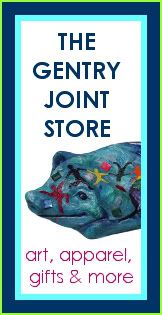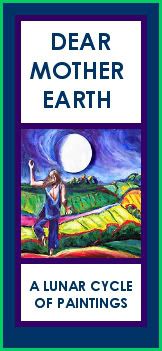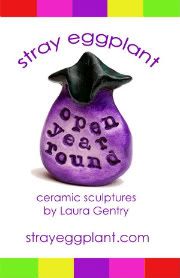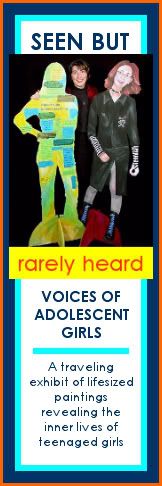A conversation with artists Laura and William Gentry
from the Tapestry Magazine, April 2004
By Michele Pettit
Last summer William Gentry, pastor of the First Congregational parishes in McGregor and Elkader, joked that if he had to chose one word to define himself it would be “and.” Defining himself with one word began as a joke, but the idea had clarity. His wife Laura Gentry, pastor of Our Savior’s Lutheran Church in Lansing and Waterville Lutheran Church, thought it would be a good idea to start asking other people the same question.
Michele: What was the origin of the Living Word project?
William: The idea came in August 2003. Surprisingly enough it started as a joke. The two of us felt we were caught in a dynamic of wanting to define ourselves as simply as possible. Which is difficult because there are lots of things we’re interested in. I said something like “The way I would describe myself would be “AND” because I always want to accumulate more gifts and talents and pursuits.” I said to Laura sort of tongue-in-cheek, “I should just have a shirt that says “and” on it.” That would become my mantra, my existence. We laughed, but then Laura said, “No, there’s something to that. We might be able to turn that into an art show.”
Laura: I said we should get a whole bunch of different people and ask them their word and put them in a show.
William: But first we had to commit ourselves to doing the idea. We don’t pursue all our ideas because sometimes we’re afraid it could be more effort than it’s worth. We wanted feedback. We wanted to find the most open-minded community that we could find and see what those people thought of the project. Laura thought of Luther College. She is an alum. We thought these are people who might be interested. That night Laura sent out 15 emails and we got excited responses.
Laura: One of the most enthusiastic was Carol Gilbertson. Carol is Luther College’s Dennis M. Jones Distinguished teaching professor in the humanities and the founder of “the poetry project.” Our Living Word project had a connection to her poetry project. Now we saw how choosing one word for yourself was like making yourself a haiku poem. Carol got a lot of students interested.
Michele: Did the project become about community? You were out there, being seen making your art, interacting with the subjects involved.
Laura: The art became about community and process, not only about the finished product. We set up a photo shoot in the atrium of the Center of the Arts on the Luther Campus in Decorah. The atrium is an open area. Students go through there all day. This involved spectators in the art. And we had the most amazing conversations with each person at the photo shoot. When William was taking their pictures I would ask, “How did you come up with your word? Tell us about it.” As they were telling their story William kept shooting photos.
William: As they were talking about their word, they were becoming the word. We wanted to capture that.
Laura: The process was fascinating. Not only how we collected people for it, but also how it was a struggle for some people to come up with their word. It took some people a month to decide on their word. It could have taken longer, but with the constraints of the project we needed a deadline. It took me a month to decide on my word. Other people had their word immediately. For example Simon Hanson, retired Luther religion professor, chose “Listener” because his name, Simon, means “listener” in Hebrew. Listener really captures who he is.
William: At first we thought we’d do 10, 20, maybe 30 of these portraits. We started shooting in October of 2003. Because of the interest generated we did a second wave in November.
Laura: The shirts were hand painted. I painted about 20 t-shirts in a night. T-shirt material is not a great surface. I wanted the words to have uniform script. That was the objective. I wanted them to look printed so the words could speak for themselves.
William: We ended up pouring over thousands of pictures. We shot on average 40 pictures of each participant. Some people had more. One participant kept moving so we shot 90 photos of her. The more expressive a person was the more difficult it was to make a choice for their picture.
Laura: We’d cull through the pictures, narrow them down to ten, to three. We’d keep looking to try to find the one picture that really fit.
William: A subtle thing could make the difference. A turn of their head, the hint of a smile, or the way the light came through. These things could bring out our feelings of the word in a portrait.
Michele: Did you consider documenting each person? Who they were and why they chose their word?
Laura: We considered it but decided on the picture only. The reasons being that you as the viewer have to bring your own ideas to it. You don’t know who this person is, what their profession is, why they chose their word. So you bring your own story to these people. The viewer is engaged with the art and makes up the rest of the story.
Michele: Did the words take on different dynamics when they were specifically tied to identity? Whenever somebody chose a word that doesn’t usually identify a person, like “and” or “possible” did the connotations of that word change?
Laura: Definitely. We encouraged people to be creative with their choices. People ended up picking all parts of speech. People don’t have to be only nouns or adjectives. Although we had a lot of adjectives, we kind of liked the verbs. I chose “if” because I liked the open-ended aspect of that word.
William: We wanted to know why people chose these words. One guy chose “bucket.” We raked him over the coals on that one. We asked him “Why did you choose bucket?” He said it started as a joke with his dorm mates but he found the word, bucket, had significance. “I could be waiting to be filled.”
Laura: One guy chose “plbbbt.” He said, “If you can find a way to spell it, that’s what I want. That’s my attitude.” The funeral director in Lansing chose the word “serious” but he chose to have his picture in his clown hat.
William: We worried we might be influencing the subjects. Everyone looked happy. Why were most of the people choosing positive words?
Michele: It could be that if you have to define yourself in one word, do you really want that one word to be negative? No.
Laura: We noticed that too. Even downtrodden people chose a positive word. How did we find all these people with positive, self-assured words? We wondered if it was because most of the people were from an academic campus.
Michele: Would people in a different environment choose different words? Would inmates in a correctional institution still want hopeful words? Maybe more so.
William: Those were those who choose a word of what they wanted to be, and those who chose a word of who they had been in the past, and those who chose a word that defined who they were at that moment.
Laura: This was also an enculturalization of an idea. We all wear t-shirts with words on them. But these words are some advertiser’s, not our own. It was empowering to say, “You can define yourself and you can be bold enough to wear your word on a t-shirt.”
Michele: Where can people see the Living Word project?
Laura: You can see it on our web page – www.thegentryjoint.com. And on April 23rd there will be a Living Word Poetry Project event at Luther College in Decorah. Organizer Carol Gilbertson will write a poem using all of the words. She’s inviting everyone who is in the show to come in his or her shirt and be part of the reading of the evening. Watch her poetry project website, www.poetryproject.luther.edu for more details.
William: The Living Word has also been accepted in “Artists in Cellophane”. There are 60 converted cigarette machines called Art*o*Mats across the country in cultural spots, whole food stores and art museum lobbies.
Laura: The founder’s concept was “Equality in Art.” Everyone should be able to afford original art and art should be available in regular places. For $5 or less you can buy a piece of original art. You pull a lever and the art pops out. We have released the first 50 portraits, alphabetically. They are mounted on a small piece of wood about the size of a cigarette pack. We got an email from a New Yorker who bought one of our pieces in Ohio. He got “Instigator” It was like a fortune cookie. He emailed us, “I’m an Instigator! I looked at all the words on your website and that word best described me.” The art is connecting people.
William: It also gives the Living Word a collector’s aspect to it. People could start collecting words. I’ve got Instigator, Quirky and Amused! Collect all ten!
Laura: Or people can make sentences out of them. You can use the portraits like magnet poetry words. We’re going to do this live at the Poetry Project event.
William: At this point the project has taken on a life of its own. The ideas have their own energy. Ultimately people are excited to define themselves instead of being defined by something or someone else. To lay claim of our voices and have ownership of a word of our own choosing is empowering.







No comments:
Post a Comment